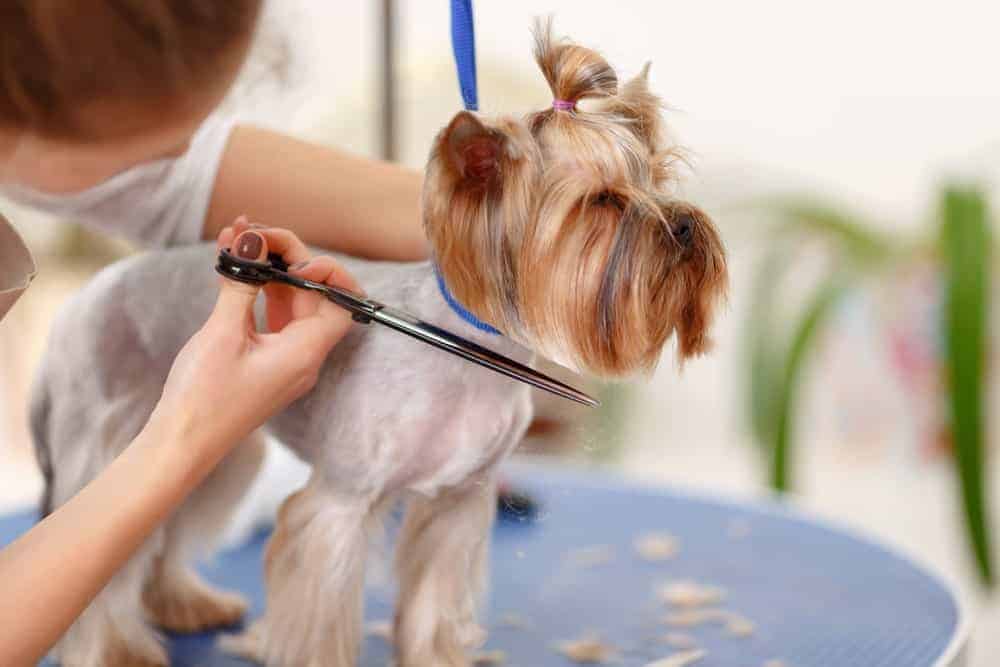In order to help your dog to feel comfortable while grooming, we need to start at the beginning. This includes his very first interaction with the shop and groomer. We start by teaching the dog that the groomer and/or the groomer’s shop are not scary. We begin by reinforcing calm behavior, and we do this by inviting prospective clients, especially those with new puppies, to come with their dogs for a visit.
This visit may be called the “Meet and Treat”. The goal of this is to look for opportunities to use treats to reinforce any calm behavior. In this way we help the dog to build up a positive and pleasant association with the groomer.
An example of what we are referring to can be found in this scenario:
When a dog is sitting patiently on the table prior to having his nails clipped, that nice sitting behavior should be reinforced. Instead of waiting until the dog moves and won’t hold his paw still for grooming, you want to be proactive and reinforce that second or two of nice, calm sitting and waiting.
Be sure not to miss those small opportunities that allow you to recognize and reinforce behavior that you like!—and, rather than becoming angry/providing attention when the dog won’t hold his paw still for trimming, be certain to recognize those quiet, still, moments of calm.
Basically, more often than not, we allow desired behaviors to just pass by without a thought, but when a behavior that we don’t like occurs—for example, the dog begins to bark at someone—we scold the animal or react in some punitive way.
Instead of responding to the behavior that we don’t like, try looking specifically for something the dog is doing that you do like—in this case, “not barking,” i.e., the silent moments between barks—and make a point of reinforcing those moments with a pat or treat while ignoring the unwanted (barking) behavior.
If the dog still seems to be displaying excitable or anxious behavior, this would be a good time to take a short break and allow the dog to relax off the table.
Even more to the point, we may have the dog at the grooming shop for several hours without realizing that he has been exhibiting behaviors that we like the whole time—such as, lying down quietly on the table, or just waiting and hanging out nicely, or perhaps coming over to you voluntarily.
These are three great examples of things that dogs do in shops every day which are, opportunities to reinforce great behaviors. A small, yummy treat, happy praise, or scratches under the chin, are examples of things that dogs often find reinforcing. Remember, reinforcing behaviors that we like means that we will see more of them!
Reinforcers
What exactly is a reinforcer? Imagine that reinforcers have a range on a scale from one to ten with ten being the top. Things that dogs may consider level “ten” reinforcers could be treats like chicken, freeze-dried lamb lung, dehydrated steak, or baked and dried hot dog bits.
Level “eight” type treats are usually something like a commercial treat such as Zukes Mini’s or Pet Botanics, with regular kibble often falling more around a level “one” on the dog’s scale. Reinforcers can also be praise, play, toys, games, or choice (such as the opportunity to move away or take a brief break).
Who decides what is reinforcing? The individual dog will be the one to determine the level of the reinforcer. For example, I may ask a person to move and sit in a chair and in turn reinforce his behavior with a $100 bill: similarly, a dog might be willing to perform the same behavior for a hamburger. As such, we want to be sure that the reinforcer that we are offering is something that the dog finds valuable.
Catching the animal in the act of doing something that you like, and reinforcing that behavior, encourages him to try this behavior again. Each time you reinforce a behavior, you are actually reinforcing future behavior, as learning is a result of reinforced repetition! Keep reinforcing behaviors that you want to see repeated, and you’ll have a happier, more relaxed grooming sessions.
Markers
A marker is a signal that lets the dog know that the behavior, he has just performed has earned him access to something that he finds reinforcing. Markers allow us to “pinpoint” the exact behavior that we like.
In order for a marker to maintain its value, it needs to be paired with a reinforcer—normally a small food item. A marker can be a word, such as “yes” or “good”; a clicker (a small, plastic device that makes a “click” sound); a whistle, or even a visual or tactile gesture. While you can use your reinforcer without a marker, a marker adds precision to the communication exchange.

